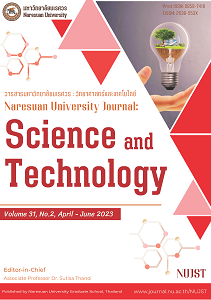Optimization of culture conditions for mycelial growth of the wild edible mushroom Phlebopus portentosus PPBR01
DOI:
https://doi.org/10.14456/nujst.2023.20Keywords:
mycelial cultivation, wild edible mushroom, Phlebopus portentosusAbstract
The objective of the present study was to optimize the optimal media and culture conditions for the mycelial growth of the wild edible mushroom, Phlebopus portentosus PPBR01 on agar medium. The mycelium of the strain was isolated from the fruiting bodies and cultured on commercial potato dextrose agar (commercial PDA) medium. To optimize the culture conditions for the mycelium growth rates of the mushrooms, various solid media, carbon and nitrogen sources, temperatures and initial pH were determined with single-factor experiments. Five local crops consisting of potato, pumpkin, taro, corn and cassava were used as the nutrient source in agar media while commercial PDA was used as the control. Among the six culture media tested, potato agar and pumpkin agar were the best for mycelia growth. Starch was the best carbon source and (NH4)2SO4 was the best nitrogen source for promoting fungal growth in terms of mycelial density. The mushrooms were found to grow best at temperatures ranging from 29-30°C. In addition, the mushroom was able to grow at a pH ranging from 5-9, with an optimal pH of 5. The present findings provide valuable information concerning optimal growth conditions for the in vitro culture of P. portentosus.
References
Ajdari, Z., Ebrahimpour, A., Manan, M. A., Hamid, M., Mohamad, R., & Ariff, A. B. (2011). Nutritional requirements for the improvement of growth and sporulation of several strains of Monascus purpureus on solid state cultivation. Journal of Biomedicine and Biotechnology, 2011(1), 487329.
Daza, A., Manjón, J. L., Camacho, M., Romero de la Osa, L., Aguilar, A., & Santamaría, C. (2006). Effect of carbon and nitrogen sources, pH and temperature on in vitro culture of several isolates of Amanita caesarea (Scop.:Fr.) Pers. Mycorrhiza, 16, 133–136.
Fang, Y-W., Wang, W-B., He, M-X., Xu, X-J., Gao, F., Liu, J., ... Zhang, C-X. (2020). Relationship between the honeydew of mealy bugs and the growth of Phlebopus portentosus. PLOS ONE, 15(6), 1-10.
Hatakeyama, T., & Ohmasa, M. (2004). Mycelial growth of strains of the genera Suillus and Boletinus in media with a wide range of concentrations of carbon and nitrogen sources. Mycoscience, 45, 169-176.
Hoa, H. T., & Wang, C. L. (2015). The effects of temperature and nutritional conditions on mycelium growth of two oyster mushrooms (Pleurotus ostreatus and Pleurotus cystidiosus). Mycobiology, 43(1), 14-23.
Inyod, T., Lattirasuvan, T., Chawananorasest, K., Toemarrom, T., Konee, C., Yatsom, S., ... Eamprasong, P. (2021). The study of optimum growth condition in some ectomycorrhizal mushroom in vitro. Naresuan Agriculture Journal, 18(1), 1-13.
Ji, K-P., Cao, Y., Zhang, C-X., He, M-X., Liu, J., Wang, W-B., & Wang, Y. (2011). Cultivation of Phlebopus portentosus in southern China. Mycological Progress, 10, 293–300.
Kumla, J., Danell, E., Bussaban, B., & Lumyong, S. (2011). Suitable growth conditions and nutrition factors on in vitro culture of Phlebopus portentosus (Boletales). Chiang Mai Journal of Science, 38(1), 156-159.
Kumla, J., Hobbie, E. A., Suwannarach, N., & Lumyong, S. (2016). The ectomycorrhizal status of a tropical black bolete, Phlebopus portentosus, assessed using mycorrhizal synthesis and isotopic analysis. Mycorrhiza, 26, 333–343.
Kumla, J., Suwannarach, N., & Lumyong, S. (2020). A new report on edible tropical bolete, Phlebopus spongiosus in Thailand and its fruiting body formation without the need for a host plant. Mycobiology, 48(4), 263-275.
LazareviĆ, J., StojiĆiĆ, D., & KeĆa, N. (2016). Effects of temperature, pH and carbon and nitrogen sources on growth of in vitro cultures of ectomycorrhizal isolates from Pinus heldreichii forest. Forest Systems, 25(1), e048.
Nhi, L. T. T., Hieu, T. C., Hanh, P. M., Tan, B. V., Hoang, P. N. D., & Quyen, H. B. T. (2017). Mycelial cultivation of Phlebopus spongiosus, an edible ectomycorrhizal mushroom in southern Vietnam. Ho Chi Minh City Open University Journal of Science, 7(1), 14-21.
Ohta, A. (1998). Fruit-body production of two ectomycorrhizal fungi in the genus Hebeloma in pure culture. Mycoscience, 39(1), 15-19.
Palmer, J. G., & Hacskaylo, E. (1970). Ectomycorrhizal fungi in pure culture I. Growth on single carbon sources. Physiologia Plantarum, 23, 1187–1197.
Rangel-Castro, J. I., Danell, E., & Taylor, A. F. S. (2002). Use of different nitrogen sources by the edible ectomycorrhizal mushroom Cantharellus cibarius. Mycorrhiza, 12, 131–137.
Sanmee, R., Dell, B., Lumyong, P., & Lumyong, S. (2010). In vitro cultivation and fruit body formation of the black bolete, Phlebopus portentosus, a popular edible ectomycorrhizal fungus in Thailand. Mycoscience, 51, 15-22.
Thongjiem, N. (2002). Pure culture of wild edible mushrooms in various media. Proceedings of the Forestry Conference, 2002, 177-185.
Thongklang, N., Hyde, K., Bussaban, B., & Lumyong, S. (2010). Culture condition, inoculum production and host response of a wild mushroom, Phlebopus portentosus strain CMUHH121-005. Maejo International Journal of Science and Technology, 5(3), 413-425.
Wanwaen, S., & Youpensuk, S. (2019). Cultivation of Amanita princeps and Gyrodon suthepensis for mycorrhizations with Castanopsis acuminatissima and their effects on the host plants. International Journal of Agriculture and Biology, 22(1), 195-200.
Zhang, C., He, M., Cao, Y., Liu, J., Gao, F., Wang, W., ... Wang, Y. (2015). Fungus-insect gall of Phlebopus portentosus. Mycologia, 107, 12–20.
Zhang, C., He, M., Liu, J., Xu, X., Cao, F., Gao, F., ... Wang, Y. (2017). Brief introduction to a unique edible bolete—Phlebopus portentosus in southern China. Journal of Agricultural Science and Technology B, 7, 386-394.
Downloads
Published
How to Cite
Issue
Section
License
Copyright (c) 2023 Naresuan University Journal: Science and Technology (NUJST)

This work is licensed under a Creative Commons Attribution-NonCommercial 4.0 International License.














